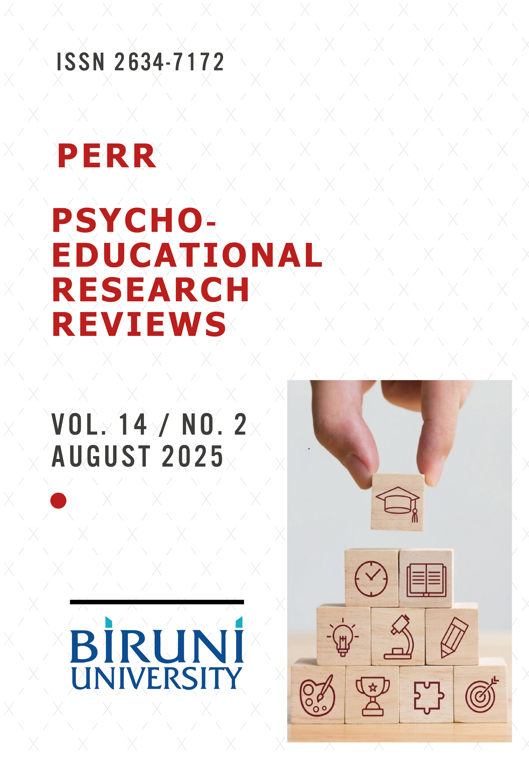Comparing Face Recognition and Visual Scanning Skills in Children With and Without Autism Using Eye-Tracking
DOI:
https://doi.org/10.52963/PERR_Biruni_V14.N2.03Keywords:
Autism spectrum disorder, Visual screening skills, Face recognition, Eye tracking, Face scanningAbstract
This study aimed to compare the visual scanning skills of children diagnosed with autism spectrum disorder (ASD) and typically developing children using eye tracking systems. The study group consisted of 37 children with ASD and 41 typically developing children aged between 3 and 10 years, who met the basic selection criteria of the study. The research applications were carried out at the Human-Computer Interaction Laboratory of the Middle East Technical University. A set of visual materials on visual scanning and recall features were prepared to compare the visual scanning skills of children with ASD and typically developing children. As a result of the statistical analysis of the data obtained from the participant children through the eye-tracking device, it was determined that children with ASD exhibited unusual visual scanning and recall characteristics that were different from those of children with typical development. Children with ASD focus their visual attention on familiar faces and objects, whereas children with typical development focus their visual attention on novel (unfamiliar) faces and objects. Based on this result, it was suggested that in educational materials to be prepared for children with ASD, human faces and stimuli with which they have developed familiarity should be preferred, taking into account the visual focus of attention. Another striking result of this study was that children with ASD tended to focus more on the stimuli (objects) when the human face and the stimuli were presented together.
Downloads
References
American Psychiatric Association. (2013). Diagnostic and statistical manual of mental disorders (5th ed.). American Psychiatric Publishing.
Black, M. H., Chen, N. T. M., Iyer, K. K., Lipp, O. V., Bölte, S., & Falkmer, M. (2021). Featural and holistic face processing in children with and without autism: An eye-tracking study. Journal of Autism and Developmental Disorders, 51(3), 889–902. https://doi.org/10.1007/s10803-020-04557-9
Bedford, R., Elsabbagh, M., Gliga, T., Pickles, A., Senju, A., Charman, T., & Johnson, M. H. (2012). Precursors to social and communication difficulties in infants at-risk for autism: Gaze following and attentional engagement. Journal of Autism and Developmental Disorders, 42(10), 2208–2218. https://doi.org/10.1007/s10803-012-1467-5
Boucher, J., & Lewis, V. (1992). Unfamiliar face recognition in relatively able autistic children. Journal of Child Psychology and Psychiatry, 33(5), 843–859. https://doi.org/10.1111/j.1469-7610.1992.tb01963.x
Bradshaw, J., Shic, F., & Chawarska, K. (2011). Brief report: Face-specific recognition deficits in young children with autism spectrum disorders. Journal of Autism and Developmental Disorders, 41(10), 1429–1435. https://doi.org/10.1007/s10803-010-1161-x
Ceyhun, A. T. (2015). Otizm spektrum bozukluğu olan çocuklar ile normal gelişim gösteren çocukların yüz işleme ve görsel tarama becerilerinin karşılaştırılarak incelenmesi [Unpublished doctoral dissertation]. Gazi Üniversitesi, Eğitim Bilimleri Enstitüsü.
Ceyhun, A. T. (2023). Otizm spektrum bozukluğu olan bireyleri gözlerinden tanımak. Nobel Yayıncılık.
Ceyhun, A. T., & Özdemir, S. (2014, Eylül). Otizm spektrum bozukluğu olan bireylerde sosyal etkileşim becerilerinde göz izleme sınırlılığı ile başlayan atipik seyir [Conference presentation]. 24. Ulusal Özel Eğitim Kongresi, Trakya Üniversitesi, Edirne, Türkiye.
Chevallier, C., Kohls, G., Troiani, V., Brodkin, E. S., & Schultz, R. T. (2012). The social motivation theory of autism. Trends in Cognitive Sciences, 16(4), 231–239. https://doi.org/10.1016/j.tics.2012.02.007
Charman, T. (2004). Matching preschool children with autism spectrum disorders and comparison children for language ability: Methodological challenges. Journal of Autism and Developmental Disorders, 34(1), 59–64. https://doi.org/10.1023/B:JADD.0000018071.42719.9f
Chawarska, K., Klin, A., Paul, R., & Volkmar, F. (2007). Autism spectrum disorder in the second year: Stability and change in syndrome expression. Journal of Child Psychology and Psychiatry, 48(2), 128–138. https://doi.org/10.1111/j.1469-7610.2006.01685.x
Chawarska, K., & Volkmar, F. (2007). Impairments in monkey and human face recognition in 2-year-old toddlers with autism spectrum disorder and developmental delay. Developmental Science, 10(2), 266–279. https://doi.org/10.1111/j.1467-7687.2007.00550.x
Chawarska, K., & Shic, F. (2009). Looking but not seeing: Atypical visual scanning and recognition of faces in 2 and 4-year-old children with autism spectrum disorder. Journal of Autism and Developmental Disorders, 39(12), 1663–1672. https://doi.org/10.1007/s10803-009-0803-7
Chawarska, K., Volkmar, F., & Klin, A. (2010). Limited attentional bias for faces in toddlers with autism spectrum disorders. Archives of General Psychiatry, 67(2), 178–185. https://doi.org/10.1001/archgenpsychiatry.2009.194
Chawarska, K., Macari, S., & Shic, F. (2012). Context modulates attention to social scenes in toddlers with autism. Journal of Child Psychology and Psychiatry, 53(8), 903–913. https://doi.org/10.1111/j.1469-7610.2012.02538.x
Dawson, G., Carver, L., Meltzoff, A. N., Panagiotides, H., McPartland, J., & Webb, S. J. (2002). Neural correlates of face and object recognition in young children with autism spectrum disorder, developmental delay, and typical development. Nature Neuroscience, 5(8), 800–806. https://doi.org/10.1038/nn857
Dawson, G., Webb, S. J., Carver, L., Panagiotides, H., & McPartland, J. (2004). Young children with autism show atypical brain responses to fearful versus neutral facial expressions of emotion. Developmental Science, 7(3), 340–359. https://doi.org/10.1111/j.1467-7687.2004.00352.x
Diken, I. H., Ardıç, A., Diken, Ö., & Gilliam, E. J. (2012). Exploring the validity and reliability of Turkish version of Gilliam Autism Rating Scale-2: Turkish standardization study. Eğitim ve Bilim, 37(165), 318–328.
Golarai, G., Grill-Spector, K., & Reiss, A. L. (2006). Autism and the development of face processing. Clinical Neuroscience Research, 6(3–4), 145–160. https://doi.org/10.1016/j.cnr.2006.06.002
Gross, T. F. (2004). The perception of four basic emotions in human and nonhuman faces by children with autism and other developmental disabilities. Journal of Abnormal Child Psychology, 32(5), 469–480. https://doi.org/10.1023/B:JACP.0000037777.84869.44
Jones, W., Carr, K., & Klin, A. (2008). Absence of preferential looking to the eyes of approaching adults predicts level of social disability in 2-year-old toddlers with autism spectrum disorder. Archives of General Psychiatry, 65(8), 946–954. https://doi.org/10.1001/archpsyc.65.8.946
Joseph, R. M., & Tanaka, J. (2003). Holistic and part-based face recognition in children with autism. Journal of Child Psychology and Psychiatry, 44(4), 529–542. https://doi.org/10.1111/1469-7610.00141
Keehn, B., Lincoln, A. J., Müller, R. A., & Townsend, J. (2022). Attentional avoidance of unfamiliar faces in children with ASD: Evidence from eye-tracking. Developmental Science, 25(3), e13211. https://doi.org/10.1111/desc.13211
Klin, A., Jones, W., Schultz, R., Volkmar, F., & Cohen, D. (2002). Visual fixation patterns during viewing of naturalistic social situations as predictors of social competence in individuals with autism. Archives of General Psychiatry, 59(9), 809–816. https://doi.org/10.1001/archpsyc.59.9.809
Klin, A., Sparrow, S. S., de Bildt, A., Cicchetti, D. V., Cohen, D. J., & Volkmar, F. R. (1999). A normed study of face recognition in autism and related disorders. Journal of Autism and Developmental Disorders, 29(6), 499–508. https://doi.org/10.1023/A:1022225310117
Mottron, L., Dawson, M., Soulières, I., Hubert, B., & Burack, J. (2006). Enhanced perceptual functioning in autism: An update, and eight principles of autistic perception. Journal of Autism and Developmental Disorders, 36(1), 27–43. https://doi.org/10.1007/s10803-005-0040-7
Mundy, P., & Burnette, C. (2005). Joint attention and neurodevelopmental models of autism. In F. R. Volkmar, R. Paul, A. Klin, & D. Cohen (Eds.), Handbook of autism and pervasive developmental disorders (Vol. 1, pp. 650–681). John Wiley & Sons.
Noris, B., Nadel, J., Barker, M., Hadjikhani, N., & Billard, A. (2012). Investigating gaze of children with ASD in naturalistic settings. PLOS ONE, 7(9), e44144. https://doi.org/10.1371/journal.pone.0044144
Özdemir, S., Gürel Selimoğlu, Ö., Töret, G., & Suna, H. E. (2017). Otizm Spektrum Bozukluğu olan çocuklar ve normal gelişim gösteren çocukların statik ve hareketli materyallerde yüz işlemelerinin karşılaştırılması. Ankara Üniversitesi Eğitim Bilimleri Fakültesi Özel Eğitim Dergisi, 18(2), 271–290.
Pascalis, O., de Haan, M., & Nelson, C. A. (2002). Is face processing species-specific during the first year of life? Science, 296(5571), 1321–1323. https://doi.org/10.1126/science.1070223
Pelphrey, K. A., Sasson, N. J., Reznick, J. S., Paul, G., Goldman, B. D., & Piven, J. (2002). Visual scanning of faces in autism. Journal of Autism and Developmental Disorders, 32(4), 249–261. https://doi.org/10.1023/A:1016374617369
Pierce, K., Conant, D., Hazin, R., Stoner, R., & Desmond, J. (2011). Preference for geometric patterns early in life as a risk factor for autism. Archives of General Psychiatry, 68(1), 101–109. https://doi.org/10.1001/archgenpsychiatry.2010.113
Rayner, K. (1998). Eye movements in reading and information processing: 20 years of research. Psychological Bulletin, 124(3), 372–422. https://doi.org/10.1037/0033-2909.124.3.372
Russell, M. (2005). Using eye-tracking data to understand first impressions of a website. Usability News, 7(1), 1–14.
Rutherford, M. D., & Towns, A. M. (2008). Scan path differences and similarities during emotion perception in those with and without autism spectrum disorders. Journal of Autism and Developmental Disorders, 38(7), 1371–1381. https://doi.org/10.1007/s10803-007-0525-7
Sasson, N., & Elison, J. T. (2012). Eye tracking young children with autism. Journal of Visualized Experiments, 61, e3795. https://doi.org/10.3791/3795
Schultz, K. N. (2005). Developmental deficits in social perception in autism: The role of the amygdala and fusiform face area. International Journal of Developmental Neuroscience, 23(2–3), 125–141. https://doi.org/10.1016/j.ijdevneu.2004.12.012
Shah, A., & Frith, U. (1993). Why do autistic individuals show superior performance on the block design task? Journal of Child Psychology and Psychiatry, 34(8), 1351–1364. https://doi.org/10.1111/j.1469-7610.1993.tb02143.x
Shic, F., Bradshaw, J., Klin, A., Scassellati, B., & Chawarska, K. (2011). Limited activity monitoring in toddlers with autism spectrum disorder. Brain Research, 1380, 246–254. https://doi.org/10.1016/j.brainres.2010.11.073
Volkmar, F., Lord, C., Bailey, A., Schultz, R. T., & Klin, A. (2004). Autism and pervasive developmental disorders. Journal of Child Psychology and Psychiatry, 45(1), 135–170. https://doi.org/10.1046/j.0021-9630.2003.00317.x
Wagner, J. B., Luyster, R. J., Tager-Flusberg, H., & Nelson, C. A. (2019). Greater visual avoidance in infants at risk for autism spectrum disorder and association with later social and emotional development. Journal of Child Psychology and Psychiatry, 60(6), 676–684. https://doi.org/10.1111/jcpp.13020
Webb, S. J., Jones, E. J., Merkle, K., Namkung, J., Toth, K., Greenson, J., Murias, M., & Dawson, G. (2010). Toddlers with elevated autism symptoms show slowed habituation to faces. Child Neuropsychology, 16(3), 255–278. https://doi.org/10.1080/09297040903559692
Additional Files
Published
How to Cite
Issue
Section
License
Copyright (c) 2025 Psycho-Educational Research Reviews

This work is licensed under a Creative Commons Attribution-NonCommercial-NoDerivatives 4.0 International License.










